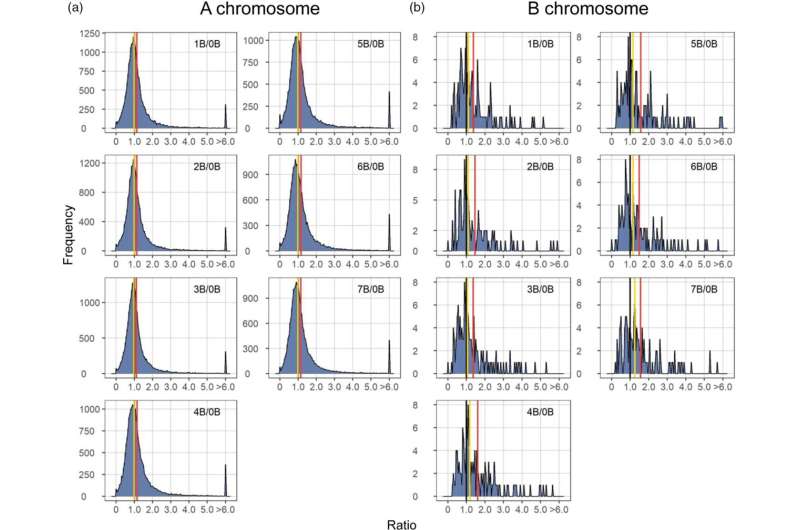Figure 1. Ratio distributions of gene expression in each experimental genotype compared with the control. (a) Ratio distributions of A-located genes. (b) Ratio distributions of B-located genes with outliers (ratio > 6 or < 1/6) removed. Normalized read counts for each gene were averaged across biological replicates and were then used for the generation of ratios comparing each experimental group to the control. Gene ratios for each comparison were plotted on the x-axis with a bin width of 0.05. The y-axis denotes the number of genes per bin (frequency). A ratio of 1.00 represents no change in the experimental genotype versus the control and is labeled with vertical lines in black. The mean and median of ratios were computed and demarcated with labeled vertical lines in red and yellow, respectively. Credit: The Plant Journal (2022). DOI: 10.1111/tpj.15665
A team of University of Missouri biologists has made a new discovery that provides novel insights into the function and properties of the maize B chromosome. The study was led by Dr. Xiaowen Shi and Dr. Hua Yang, postdoctoral fellows in the Birchler lab, and reported in the January 2022 issue of the Plant Journal.
Apart from the 20 normal A chromosomes, maize contains a nonessential B chromosome that can be present or absent from some individuals within a population. This chromosome has properties that drive its transmission in populations despite being nonessential. The maize B chromosome has wide applications in various genetic studies, including experimental mapping, chromosomal dosage studies, chromosomal behavior, and genetic engineering of minichromosomes. Although the maize B chromosome was discovered nearly a century ago, it has been thought to be an essentially inert chromosome. However, little was known about the function and properties of the maize B chromosome.
In a study investigating the effect of the B chromosome on gene expression through RNA sequencing, the authors demonstrate that 273 out of 758 predicted B chromosome-located genes are actively transcribed in leaf tissue. The B chromosome causes differential expression of genes, microRNAs (miRNAs), and transposable elements (TEs). Modulations of A chromosome-located genes are largely determined by the presence rather than the copy number of the B chromosome. By contrast, the expression of most B chromosome-located genes is positively correlated with B copy number, showing a proportional gene dosage effect. Furthermore, A chromosome-located miRNAs participate in the regulation of A chromosome gene expression under the impact of the B chromosome and could potentially modulate its targets in a cascade of effects.
The study demonstrates that the B chromosome is not totally inert. The presence of the B chromosome results in changes in gene expression both transcriptionally and post-transcriptionally. An increase of B copy number causes both cumulative effects and non-cumulative effects on the expression of genes, miRNAs, and TEs.
More information: Xiaowen Shi et al, Effect of aneuploidy of a non‐essential chromosome on gene expression in maize, The Plant Journal (2022). DOI: 10.1111/tpj.15665
Journal information: The Plant Journal
Provided by University of Missouri























